fuel MITSUBISHI OUTLANDER PHEV 2014 Owner's Manual (in English)
[x] Cancel search | Manufacturer: MITSUBISHI, Model Year: 2014, Model line: OUTLANDER PHEV, Model: MITSUBISHI OUTLANDER PHEV 2014Pages: 442, PDF Size: 19.04 MB
Page 2 of 442
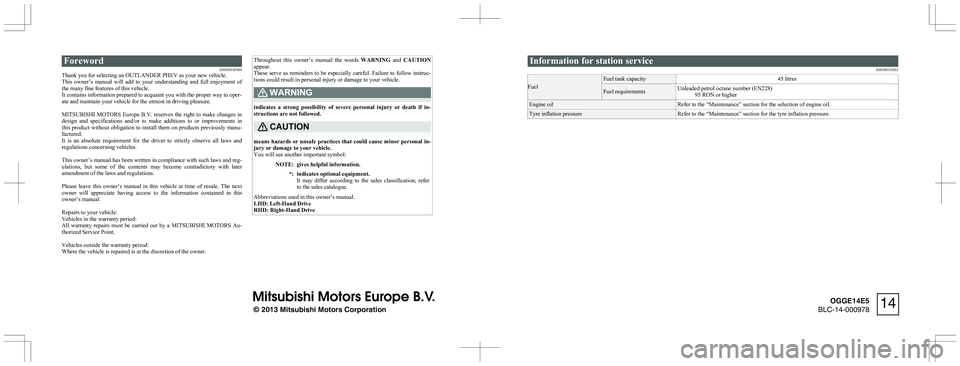
ForewordE09200105969
Thank you for selecting an OUTLANDER PHEV as your new vehicle.
This owner’s manual will add to your understanding and full enjoyment of
the many fine features of this vehicle.
It contains information prepared to acquaint you with the proper way to oper-
ate and maintain your vehicle for the utmost in driving pleasure.
MITSUBISHI MOTORS Europe B.V. reserves the right to make changes in
design and specifications and/or to make additions to or improvements in
this product without obligation to install them on products previously manu- factured.
It is an absolute requirement for the driver to strictly observe all laws and
regulations concerning vehicles.
This owner’s manual has been written in compliance with such laws and reg- ulations, but some of the contents may become contradictory with later amendment of the laws and regulations.
Please leave this owner’s manual in this vehicle at time of resale. The next
owner will appreciate having access to the information contained in this
owner’s manual.
Repairs to your vehicle:
Vehicles in the warranty period:
All warranty repairs must be carried out by a MITSUBISHI MOTORS Au-
thorized Service Point.
Vehicles outside the warranty period:
Where the vehicle is repaired is at the discretion of the owner.
Throughout this owner’s manual the words WARNING and CAUTION
appear.
These serve as reminders to be especially careful. Failure to follow instruc-
tions could result in personal injury or damage to your vehicle.WARNING
indicates a strong possibility of severe personal injury or death if in- structions are not followed.
CAUTION
means hazards or unsafe practices that could cause minor personal in-
jury or damage to your vehicle.
You will see another important symbol:
NOTE:gives helpful information.*:indicates optional equipment.
It may differ according to the sales classification; refer to the sales catalogue.
Abbreviations used in this owner’s manual:
LHD: Left-Hand Drive
RHD: Right-Hand Drive
Information for station service
E09300103852Fuel
Fuel tank capacity45 litresFuel requirementsUnleaded petrol octane number (EN228)95 RON or higherEngine oilRefer to the “Maintenance” section for the selection of engine oil.Tyre inflation pressureRefer to the “Maintenance” section for the tyre inflation pressure.
© 2013 Mitsubishi Motors Corporation
14
OGGE14E5
BLC-14-000978
Page 6 of 442
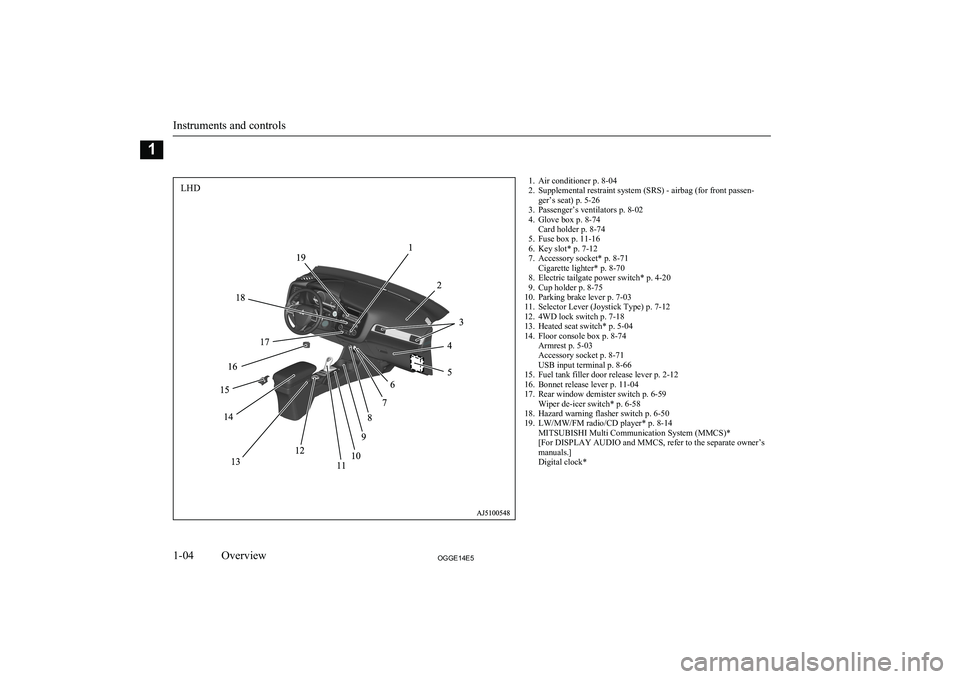
1. Air conditioner p. 8-04
2. Supplemental restraint system (SRS) - airbag (for front passen- ger’s seat) p. 5-26
3. Passenger’s ventilators p. 8-02
4. Glove box p. 8-74 Card holder p. 8-74
5. Fuse box p. 11-16
6. Key slot* p. 7-12
7. Accessory socket* p. 8-71 Cigarette lighter* p. 8-70
8. Electric tailgate power switch* p. 4-20
9. Cup holder p. 8-75
10. Parking brake lever p. 7-03
11. Selector Lever (Joystick Type) p. 7-12
12. 4WD lock switch p. 7-18
13. Heated seat switch* p. 5-04
14. Floor console box p. 8-74 Armrest p. 5-03
Accessory socket p. 8-71
USB input terminal p. 8-66
15. Fuel tank filler door release lever p. 2-12
16. Bonnet release lever p. 11-04
17. Rear window demister switch p. 6-59 Wiper de-icer switch* p. 6-58
18. Hazard warning flasher switch p. 6-50
19. LW/MW/FM radio/CD player* p. 8-14 MITSUBISHI Multi Communication System (MMCS)*
[For DISPLAY AUDIO and MMCS, refer to the separate owner’s
manuals.]
Digital clock*
Instruments and controls
1-04OGGE14E5Overview1LHD
Page 7 of 442
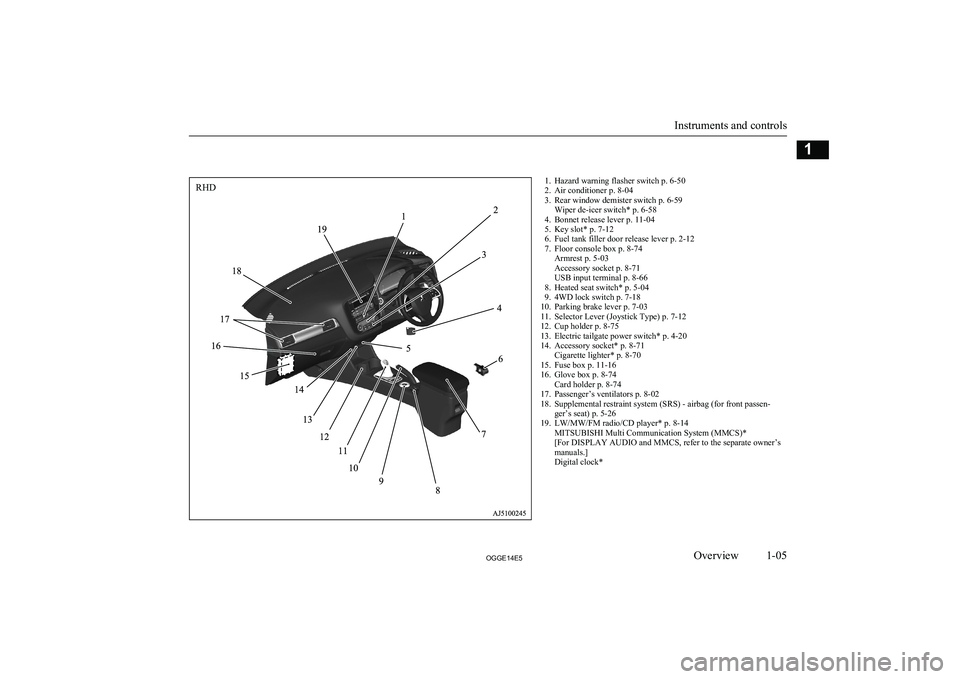
1. Hazard warning flasher switch p. 6-50
2. Air conditioner p. 8-04
3. Rear window demister switch p. 6-59 Wiper de-icer switch* p. 6-58
4. Bonnet release lever p. 11-04
5. Key slot* p. 7-12
6. Fuel tank filler door release lever p. 2-12
7. Floor console box p. 8-74 Armrest p. 5-03
Accessory socket p. 8-71
USB input terminal p. 8-66
8. Heated seat switch* p. 5-04
9. 4WD lock switch p. 7-18
10. Parking brake lever p. 7-03
11. Selector Lever (Joystick Type) p. 7-12
12. Cup holder p. 8-75
13. Electric tailgate power switch* p. 4-20
14. Accessory socket* p. 8-71 Cigarette lighter* p. 8-70
15. Fuse box p. 11-16
16. Glove box p. 8-74 Card holder p. 8-74
17. Passenger’s ventilators p. 8-02
18. Supplemental restraint system (SRS) - airbag (for front passen- ger’s seat) p. 5-26
19. LW/MW/FM radio/CD player* p. 8-14 MITSUBISHI Multi Communication System (MMCS)*
[For DISPLAY AUDIO and MMCS, refer to the separate owner’s
manuals.]
Digital clock*
Instruments and controls
1-05OGGE14E5Overview1RHD
Page 13 of 442
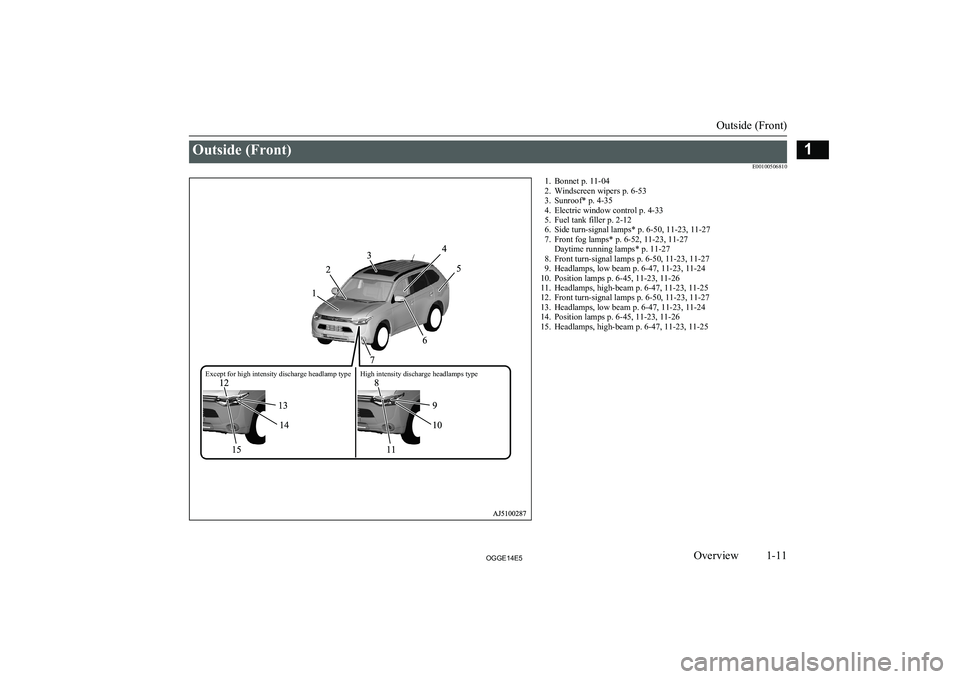
Outside (Front)E001005068101. Bonnet p. 11-042. Windscreen wipers p. 6-53
3. Sunroof* p. 4-35
4. Electric window control p. 4-33
5. Fuel tank filler p. 2-12
6. Side turn-signal lamps* p. 6-50, 11-23, 11-27
7. Front fog lamps* p. 6-52, 11-23, 11-27 Daytime running lamps* p. 11-27
8. Front turn-signal lamps p. 6-50, 11-23, 11-27
9. Headlamps, low beam p. 6-47, 11-23, 11-24
10. Position lamps p. 6-45, 11-23, 11-26
11. Headlamps, high-beam p. 6-47, 11-23, 11-25
12. Front turn-signal lamps p. 6-50, 11-23, 11-27
13. Headlamps, low beam p. 6-47, 11-23, 11-24
14. Position lamps p. 6-45, 11-23, 11-26
15. Headlamps, high-beam p. 6-47, 11-23, 11-25
Outside (Front)
1-11OGGE14E5Overview1Except for high intensity discharge headlamp type High intensity discharge headlamps type
Page 15 of 442
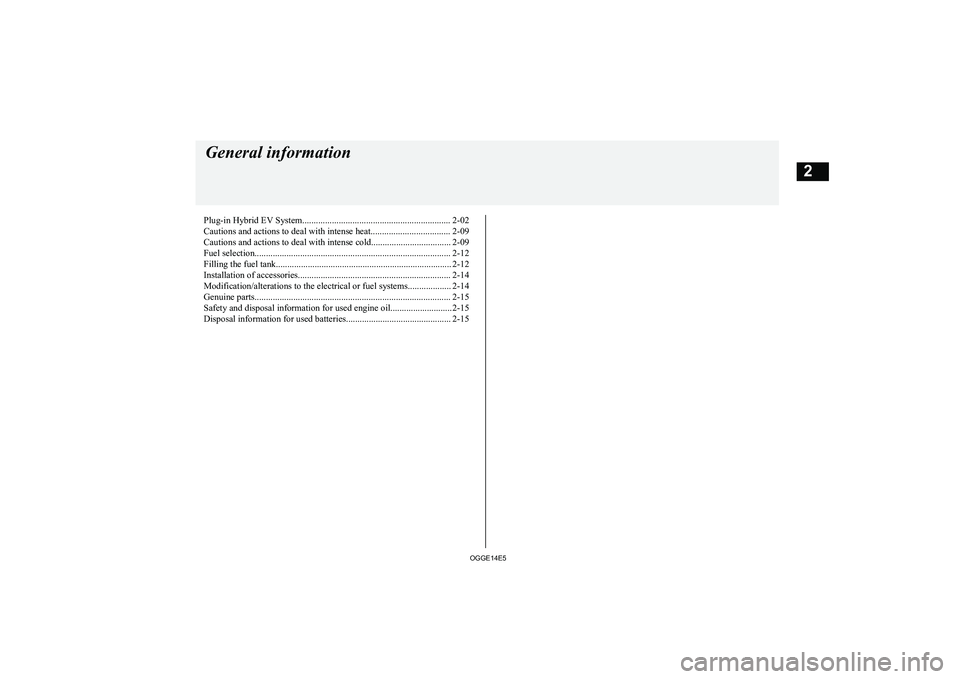
Plug-in Hybrid EV System................................................................. 2-02
Cautions and actions to deal with intense heat................................... 2-09 Cautions and actions to deal with intense cold................................... 2-09Fuel selection...................................................................................... 2-12Filling the fuel tank............................................................................. 2-12Installation of accessories................................................................... 2-14
Modification/alterations to the electrical or fuel systems................... 2-14
Genuine parts...................................................................................... 2-15 Safety and disposal information for used engine oil........................... 2-15
Disposal information for used batteries.............................................. 2-15General information
OGGE14E52
Page 17 of 442
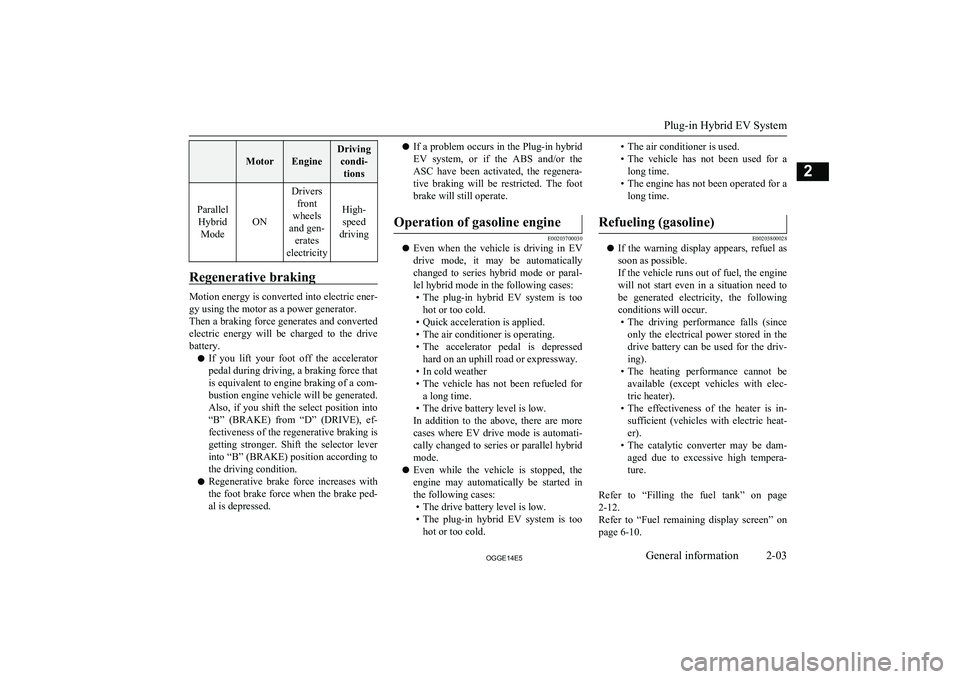
MotorEngine
Drivingcondi- tions
ParallelHybrid Mode
ON
Drivers front
wheels
and gen- erates
electricity
High- speed
driving
Regenerative braking
Motion energy is converted into electric ener-
gy using the motor as a power generator.
Then a braking force generates and converted electric energy will be charged to the drive
battery.
l If you lift your foot off the accelerator
pedal during driving, a braking force that
is equivalent to engine braking of a com- bustion engine vehicle will be generated.
Also, if you shift the select position into “B” (BRAKE) from “D” (DRIVE), ef-
fectiveness of the regenerative braking is getting stronger. Shift the selector lever into “B” (BRAKE) position according to
the driving condition.
l Regenerative brake force increases with
the foot brake force when the brake ped-
al is depressed.
l If a problem occurs in the Plug-in hybrid
EV system, or if the ABS and/or the ASC have been activated, the regenera-
tive braking will be restricted. The foot brake will still operate.Operation of gasoline engine
E00203700030
l Even when the vehicle is driving in EV
drive mode, it may be automatically
changed to series hybrid mode or paral-
lel hybrid mode in the following cases: • The plug-in hybrid EV system is too
hot or too cold.
• Quick acceleration is applied.
• The air conditioner is operating.
• The accelerator pedal is depressed
hard on an uphill road or expressway.
• In cold weather
• The vehicle has not been refueled for
a long time.
• The drive battery level is low.
In addition to the above, there are more
cases where EV drive mode is automati-
cally changed to series or parallel hybrid mode.
l Even while the vehicle is stopped, the
engine may automatically be started in the following cases: • The drive battery level is low.
• The plug-in hybrid EV system is too
hot or too cold.
• The air conditioner is used.
• The vehicle has not been used for a
long time.
• The engine has not been operated for a long time.Refueling (gasoline)
E00203800028
l If the warning display appears, refuel as
soon as possible.
If the vehicle runs out of fuel, the engine will not start even in a situation need to be generated electricity, the following
conditions will occur. • The driving performance falls (since
only the electrical power stored in the drive battery can be used for the driv-
ing).
• The heating performance cannot be
available (except vehicles with elec-
tric heater).
• The effectiveness of the heater is in-
sufficient (vehicles with electric heat-er).
• The catalytic converter may be dam-
aged due to excessive high tempera- ture.
Refer to “Filling the fuel tank” on page 2-12.
Refer to “Fuel remaining display screen” on page 6-10.
Plug-in Hybrid EV System
2-03OGGE14E5General information2
Page 18 of 442
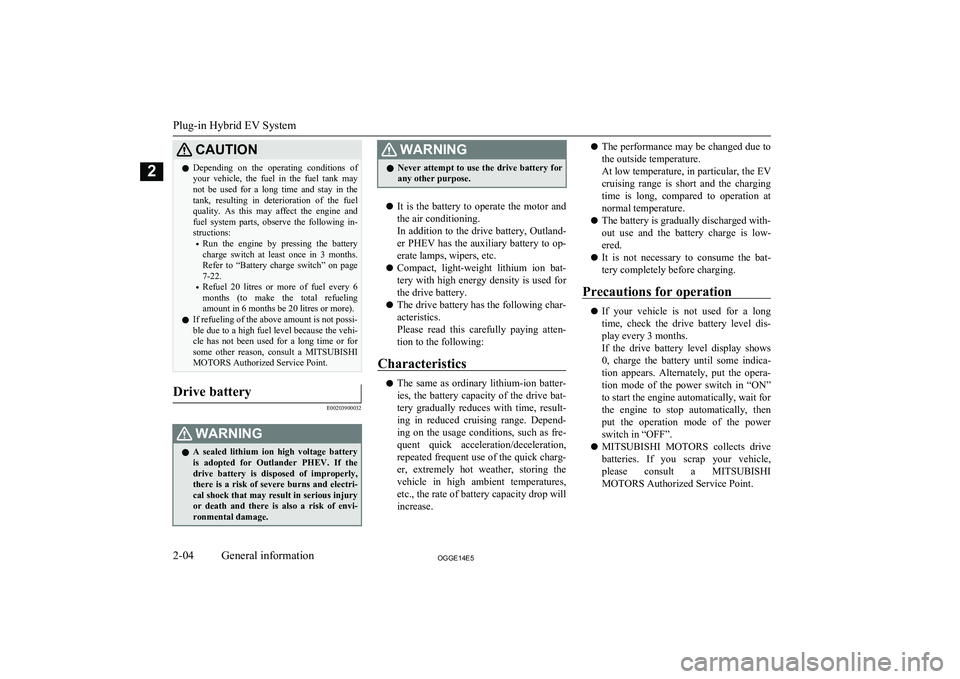
CAUTIONlDepending on the operating conditions of
your vehicle, the fuel in the fuel tank may
not be used for a long time and stay in the tank, resulting in deterioration of the fuel
quality. As this may affect the engine and fuel system parts, observe the following in-
structions:
• Run the engine by pressing the battery
charge switch at least once in 3 months.
Refer to “Battery charge switch” on page 7-22.
• Refuel 20 litres or more of fuel every 6
months (to make the total refueling amount in 6 months be 20 litres or more).
l If refueling of the above amount is not possi-
ble due to a high fuel level because the vehi-
cle has not been used for a long time or for
some other reason, consult a MITSUBISHI
MOTORS Authorized Service Point.Drive battery
E00203900032
WARNINGl A sealed lithium ion high voltage battery
is adopted for Outlander PHEV. If the
drive battery is disposed of improperly, there is a risk of severe burns and electri-
cal shock that may result in serious injury
or death and there is also a risk of envi- ronmental damage.WARNINGl Never attempt to use the drive battery for
any other purpose.
l It is the battery to operate the motor and
the air conditioning.
In addition to the drive battery, Outland-
er PHEV has the auxiliary battery to op-
erate lamps, wipers, etc.
l Compact, light-weight lithium ion bat-
tery with high energy density is used forthe drive battery.
l The drive battery has the following char-
acteristics.
Please read this carefully paying atten- tion to the following:
Characteristics
l The same as ordinary lithium-ion batter-
ies, the battery capacity of the drive bat-
tery gradually reduces with time, result- ing in reduced cruising range. Depend-
ing on the usage conditions, such as fre- quent quick acceleration/deceleration, repeated frequent use of the quick charg-
er, extremely hot weather, storing the vehicle in high ambient temperatures, etc., the rate of battery capacity drop willincrease.
l The performance may be changed due to
the outside temperature.
At low temperature, in particular, the EV cruising range is short and the charging
time is long, compared to operation at normal temperature.
l The battery is gradually discharged with-
out use and the battery charge is low- ered.
l It is not necessary to consume the bat-
tery completely before charging.
Precautions for operation
l If your vehicle is not used for a long
time, check the drive battery level dis- play every 3 months.
If the drive battery level display shows
0, charge the battery until some indica-
tion appears. Alternately, put the opera- tion mode of the power switch in “ON”to start the engine automatically, wait for
the engine to stop automatically, then
put the operation mode of the power
switch in “OFF”.
l MITSUBISHI
MOTORS collects drive
batteries. If you scrap your vehicle,
please consult a MITSUBISHI
MOTORS Authorized Service Point.
Plug-in Hybrid EV System
2-04OGGE14E5General information2
Page 20 of 442
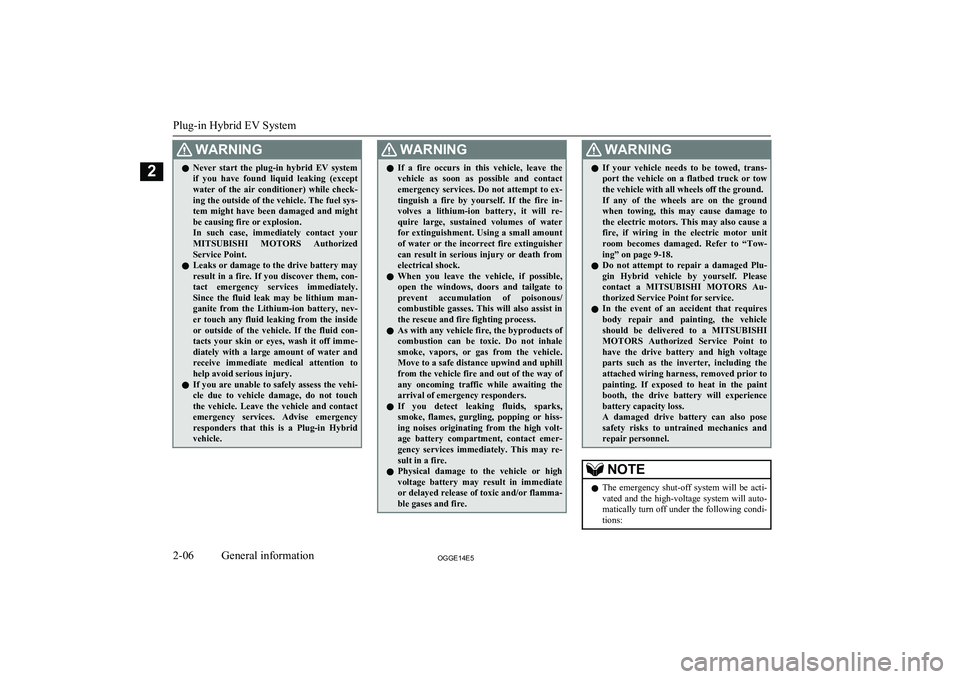
WARNINGlNever start the plug-in hybrid EV system
if you have found liquid leaking (exceptwater of the air conditioner) while check- ing the outside of the vehicle. The fuel sys-
tem might have been damaged and might be causing fire or explosion.
In such case, immediately contact your MITSUBISHI MOTORS Authorized
Service Point.
l Leaks or damage to the drive battery may
result in a fire. If you discover them, con-
tact emergency services immediately.
Since the fluid leak may be lithium man- ganite from the Lithium-ion battery, nev- er touch any fluid leaking from the inside
or outside of the vehicle. If the fluid con- tacts your skin or eyes, wash it off imme-
diately with a large amount of water and receive immediate medical attention to
help avoid serious injury.
l If you are unable to safely assess the vehi-
cle due to vehicle damage, do not touch the vehicle. Leave the vehicle and contact
emergency services. Advise emergency responders that this is a Plug-in Hybrid
vehicle.WARNINGl If a fire occurs in this vehicle, leave the
vehicle as soon as possible and contact
emergency services. Do not attempt to ex- tinguish a fire by yourself. If the fire in-
volves a lithium-ion battery, it will re- quire large, sustained volumes of water for extinguishment. Using a small amount
of water or the incorrect fire extinguisher
can result in serious injury or death from electrical shock.
l When you leave the vehicle, if possible,
open the windows, doors and tailgate to
prevent accumulation of poisonous/ combustible gasses. This will also assist in
the rescue and fire fighting process.
l As with any vehicle fire, the byproducts of
combustion can be toxic. Do not inhale
smoke, vapors, or gas from the vehicle. Move to a safe distance upwind and uphill
from the vehicle fire and out of the way of any oncoming traffic while awaiting the
arrival of emergency responders.
l If you detect leaking fluids, sparks,
smoke, flames, gurgling, popping or hiss-
ing noises originating from the high volt- age battery compartment, contact emer-
gency services immediately. This may re- sult in a fire.
l Physical damage to the vehicle or high
voltage battery may result in immediate or delayed release of toxic and/or flamma- ble gases and fire.WARNINGl If your vehicle needs to be towed, trans-
port the vehicle on a flatbed truck or tow
the vehicle with all wheels off the ground.
If any of the wheels are on the ground when towing, this may cause damage to
the electric motors. This may also cause a
fire, if wiring in the electric motor unit room becomes damaged. Refer to “Tow-
ing” on page 9-18.
l Do not attempt to repair a damaged Plu-
gin Hybrid vehicle by yourself. Please contact a MITSUBISHI MOTORS Au-
thorized Service Point for service.
l In the event of an accident that requires
body repair and painting, the vehicle should be delivered to a MITSUBISHI
MOTORS Authorized Service Point to
have the drive battery and high voltage parts such as the inverter, including the
attached wiring harness, removed prior to painting. If exposed to heat in the paint
booth, the drive battery will experience battery capacity loss.
A damaged drive battery can also pose
safety risks to untrained mechanics and repair personnel.NOTEl The emergency shut-off system will be acti-
vated and the high-voltage system will auto- matically turn off under the following condi-
tions:
Plug-in Hybrid EV System
2-06OGGE14E5General information2
Page 26 of 442

Fuel selectionE00200104275Recom-
mended fuelUnleaded petrol octane number(EN228) 95 RON or higherCAUTIONlThe use of leaded fuel can result in serious
damage to the engine and catalytic convert- er. Do not use leaded fuel.NOTEl Poor quality petrol can cause problems such
as difficult starting, stalling, engine noise
and hesitation. If you experience these prob- lems, try another brand and/or grade of pet-
rol.
If the check engine warning lamp flashes,
have the system checked as soon as possible at a MITSUBISHI MOTORS Authorized
Service Point.
E10 type petrol
The petrol engine are compatible with E10
type petrol (containing 10 % ethanol) con- forming to European standards EN 228.
CAUTIONl Do not use more than 10 % concentration of
ethanol (grain alcohol) by volume.
Use of more than 10 % concentration may
lead to damage to your vehicle fuel system,
engine, engine sensors and exhaust system.Filling the fuel tank
E00200203804WARNINGlWhen handling fuel, comply with the safe-
ty regulations displayed by garages and
filling stations.
l Gasoline is highly flammable and explo-
sive. You could be burned or seriously in-
jured when handling it. When refueling
your vehicle, always put the operation mode of the power switch in OFF and
keep away from flames, sparks, and smoking materials. Always handle fuel in
well-ventilated outdoor areas.
l Before removing the fuel cap, be sure to
get rid of your body’s static electricity by
touching a metal part of the car or the fuel pump. Any static electricity on your
body could create a spark that ignites fuel vapour.WARNINGl Perform the whole refueling process
(opening the fuel tank filler door, remov- ing the fuel cap, etc.) by yourself. Do notlet any other person come near the fuel
tank filler. If you allowed a person to help you and that person was carrying static
electricity, fuel vapour could be ignited.
l Do not perform charging and refueling at
the same time. If you charged with staticelectricity, fuel vapour could be ignited by the discharge spark.
l Do not move away from the fuel tank fill-
er until refueling is finished. If you moved away and did something else (for exam-
ple, sitting on a seat) part-way through the refueling process, you could pick up afresh charge of static electricity.
l Be careful not to inhale fuel vapour. Fuel
contains toxic substances.
l Keep the doors and windows closed while
refueling the vehicle. If they were open,fuel vapour could get into the cabin.
l If the tank cap must be replaced, use only
a MITSUBISHI MOTORS genuine part.CAUTIONl Depending on the operating conditions of
your vehicle, the fuel in the fuel tank may
not be used for a long time and stay in the tank, resulting in deterioration of the fuel
quality. As this may affect the engine and
Fuel selection
2-12OGGE14E5General information2
Page 27 of 442
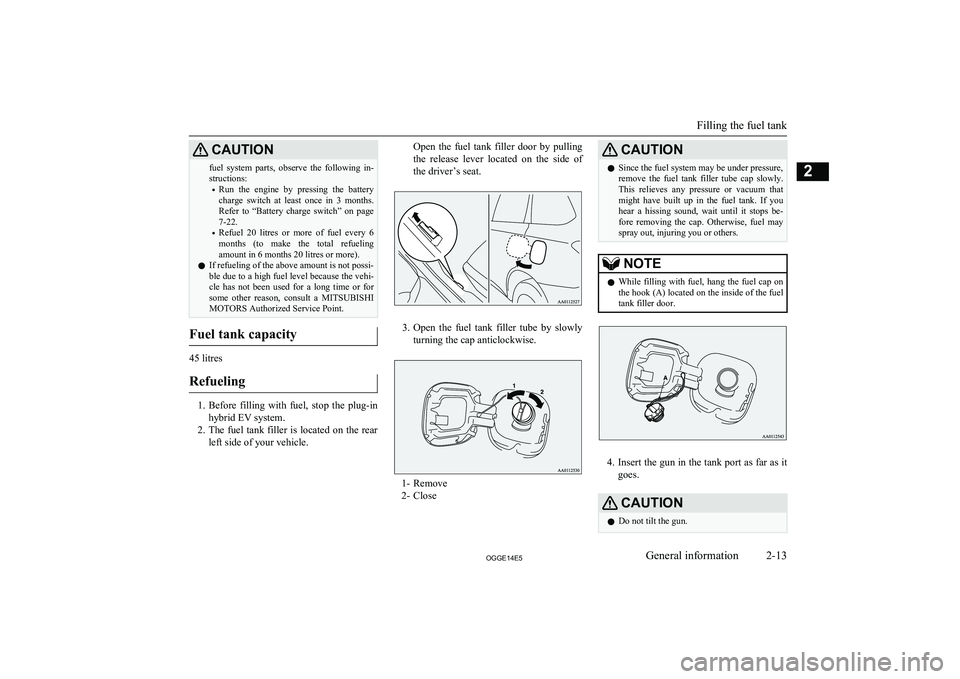
CAUTIONfuel system parts, observe the following in-structions:
• Run the engine by pressing the battery
charge switch at least once in 3 months. Refer to “Battery charge switch” on page 7-22.
• Refuel 20 litres or more of fuel every 6
months (to make the total refueling amount in 6 months 20 litres or more).
l If refueling of the above amount is not possi-
ble due to a high fuel level because the vehi-
cle has not been used for a long time or for
some other reason, consult a MITSUBISHI
MOTORS Authorized Service Point.
Fuel tank capacity
45 litres
Refueling
1. Before filling with fuel, stop the plug-in
hybrid EV system.
2. The fuel tank filler is located on the rear
left side of your vehicle.
Open the fuel tank filler door by pulling
the release lever located on the side of the driver’s seat.
3. Open the fuel tank filler tube by slowly
turning the cap anticlockwise.
1- Remove
2- Close
CAUTIONl Since the fuel system may be under pressure,
remove the fuel tank filler tube cap slowly. This relieves any pressure or vacuum that
might have built up in the fuel tank. If you
hear a hissing sound, wait until it stops be- fore removing the cap. Otherwise, fuel may
spray out, injuring you or others.NOTEl While filling with fuel, hang the fuel cap on
the hook (A) located on the inside of the fuel
tank filler door.
4. Insert the gun in the tank port as far as it
goes.
CAUTIONl Do not tilt the gun.
Filling the fuel tank
2-13OGGE14E5General information2